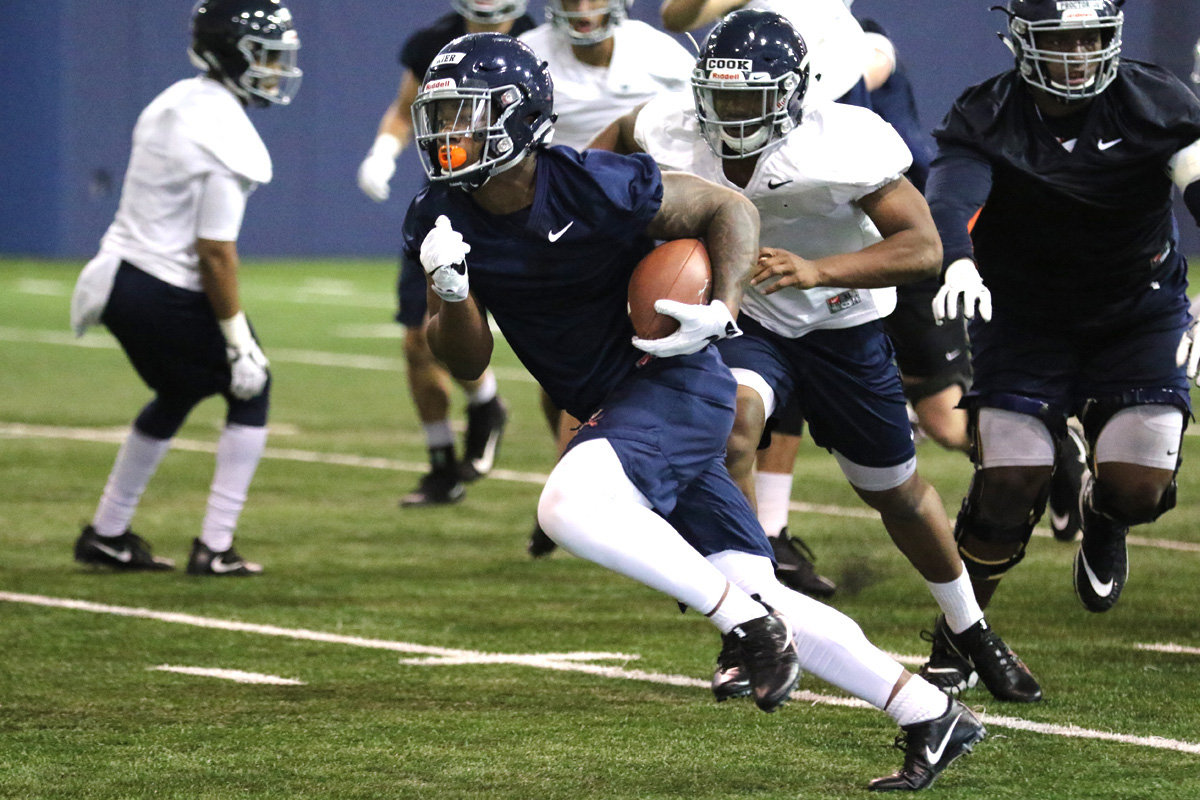
The Virginia football team’s coaches presented a clear mission to the offense this spring: improve the running game. With that in mind, practice outlines have involved a heavy dose of running plays for the Cavaliers.
That makes sense. UVA can gain significant ground – pun intended – offensively by improving the running game. The Hoos ranked last in the ACC each of the last two seasons. In 2016, they managed 113.58 rushing yards per game and that fell to 93.54 rushing yards per game in 2017. Even with pocket passer and NFL Draft hopeful Kurt Benkert at quarterback setting passing records for the program, the lack of balance often troubled the offense.
“We have to run the ball much more effectively than we have been,” Virginia coach Bronco Mendenhall said. “We’re putting disproportionate time and energy and resources into that this spring.”
The emphasis has been clear. The Cavaliers didn’t even really look at third-and-long situations, for example, until halfway through the spring’s 15 allotted practices. Offensive line coach Garett Tujague joked that if asked about pass protection reps this spring, his players should say zero. The clear message is on “willing” the run game to work, he said.
Part of the mindset this spring comes in step with Benkert’s time ending at Virginia. When the East Carolina graduate transfer enrolled at Virginia with two years of eligibility, the coaches tailored the offense’s approach to his strengths while trying to create a stable foundation for the program. That led to a pass-heavy offense that saw Benkert leave UVA as the single-season program leader in passing yards with 3,207, completions with 298, and attempts with 509, all set in 2017. Over two seasons, Benkert threw 46 touchdown passes with 20 interceptions.
An unclear succession plan led Virginia to add two quarterbacks this spring. Arizona Western Community College transfer Bryce Perkins and true freshman Brennan Armstrong each enrolled in January in order to participate in spring drills. Both players represent a move toward this coaching staff’s preferred quarterback mold of dual threats in the running and passing game.
Perkins opened spring practice at the top of the depth chart thanks to his showing in winter workouts and his experience in leading the Matadors to the 2017 NJCAA Championship Game. He passed for 1,311 yards and seven touchdowns and rushed for 353 yards and four touchdowns last season at AWCC. It’s easy to see how that could translate to Virginia’s shifting plans offensively. With more option plays – classic option, read option, and run-pass options all included – in the playbook, the threat of someone that can hurt a defense in both categories is huge.
Perkins already has flashed some of his burst through openings and top-end straight-line speed in practices this spring.
“Bryce is tremendously athletic and he can gobble up space when he gets out on the edge,” UVA offensive coordinator Robert Anae said. “He’s got a deep ball so those are kind of the high points right now with Bryce.”
Plus, Perkins has a little bit of wiggle too. That means even pure passing plays that break down can become running plays since he can escape the pocket if needed. That’s one area that Tujague’s group is adjusting to this spring.
“The learning curve right now for my guys would be if he extends a play outside the pocket to be able to know when to drop our hands to free up the D-End as he’s going to make a play out there and then working to gain leverage back,” Tujague said. “We got called [in practice] on a hold when Bryce came out and [the lineman] yanked on it because he didn’t know where Bryce was going. Going through those little things. There’s nothing better than having the opportunity to protect for somebody that has the ability that Bryce has.”
Virginia potentially has more playable running back depth than a year ago as well. Last fall, Jordan Ellis logged 215 carries while no other player surpassed 27. Ellis returns for his senior season so that gives the offense the option of a workhorse type of back again, but true freshmen Lamont Atkins, PK Kier, and Jamari Peacock all saw action last fall and that should help build toward heavier use as sophomores. Throw in Chris Sharp, who switched from defense to offense last fall, and that’s another player that picked up experience in limited action in 2017.
There’s the option of keeping receivers Olamide Zaccheaus and Joe Reed in the running attack too. Both got carries last season. Zaccheaus recorded the second-most carries on the team with 27 for an average of 6.7 yards per carry, while Reed tallied 21 carries for an average of 5.3 yards per carry.
“Sometimes we’ve got three backs, sometimes we’ve got four backs out there running around,” Anae said. “So lots of running backs. It’s like Santa Claus showed up and all the presents were ‘oh running backs!’”
So far, the progress has been encouraging to the coaches.
“I do believe we will be a way better run team that we’ve been in the past,” Anae said. “That’s my take and I’m pretty confident in it. We will be able to run the ball better. I believe that because we are better in all areas of the offense where that was not a strength the two years prior.”




It was blatantly obvious that our lack of a running game was a major reason for the lack of offensive production against quality programs. It absolutely has to improve in order to be competitive in every game.